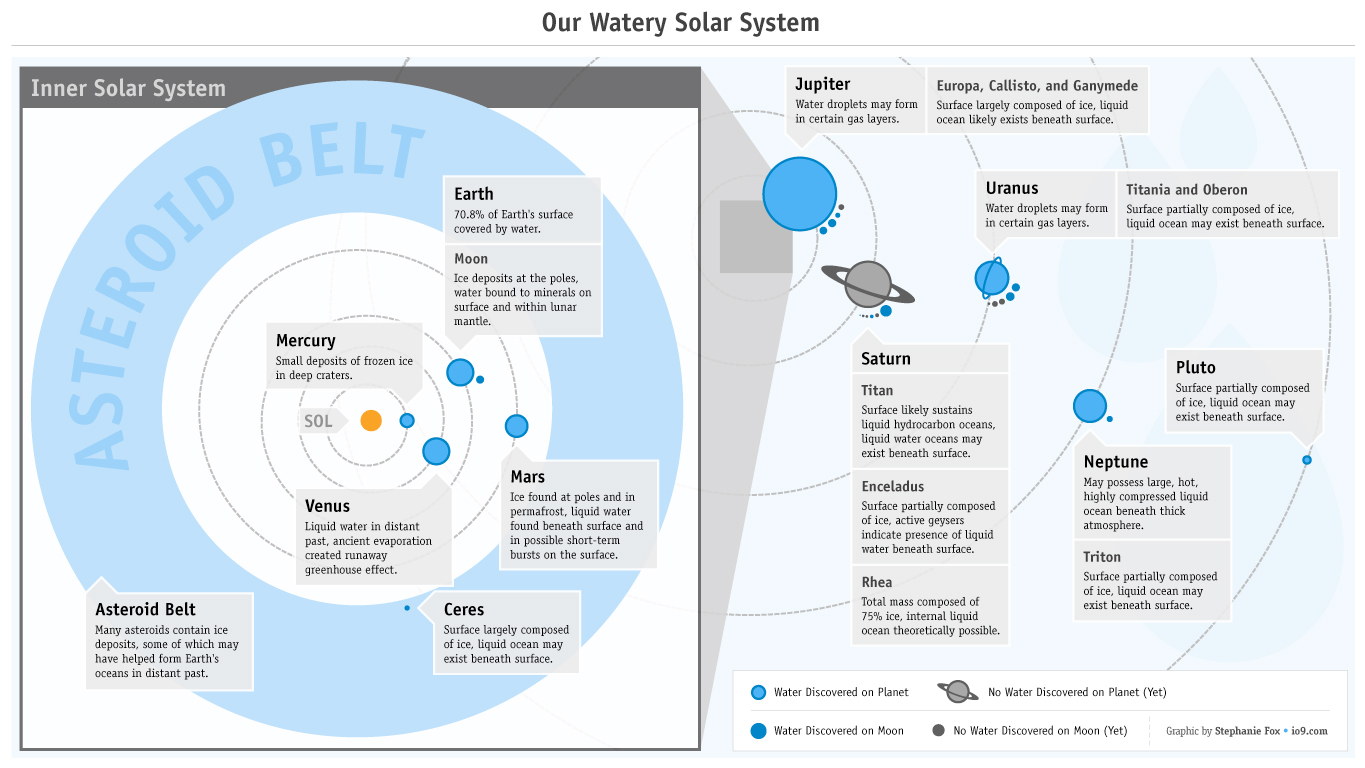We've just learned that
there's strong evidence that saltwater flows on the surface of Mars. It's another reminder that water is everywhere in our solar system, whether it's ice, vapor, or liquid. Here's a handy guide to where all the water can be found.
Our map is mainly focused on the places where we might find liquid water. There's a simple reason for that: Water molecules are incredibly bountiful throughout our solar system. Pretty much anywhere that there's an atmosphere, there's water vapor in it, and a huge percentage of the rocks in our solar system contain some amount of ice. So let's instead examine where conditions are just right for liquid water to exist.

© Stephanie Fox
There's only one body in the solar system where we have indisputable evidence that there's liquid water on the surface - that, of course, would be Earth, although it now looks like Mars is the second, albeit on a much, much smaller scale. Going back billions of years, there's good evidence to think that Venus and Mars both supported large, Earth-like bodies of water, before changing climates made one too hot and the other too cold to support them any longer.
Most other rocky objects have ice on the surface. Just in the inner solar system, that includes the Moon, Mars, and Mercury. It's when you dive deep into the crust that you find large, subterranean oceans of liquid water. Pretty much all the various moons on this map, along with Kuiper Belt objects like Pluto, are thought to have oceans hidden roughly 100 kilometers beneath their icy crusts.
Now, most of these oceans remain hypothetical - the one we're closest to certain about is Jupiter's moon Europa. But even that ocean's existence isn't absolutely definite - we only have indirect evidence. If they exist, these lunar oceans are maintained by various internal heating processes, particularly radioactive decay within the satellites' cores. Again, if we go back far enough, it's possible that the icy exteriors of some of these bodies were once watery too, but they've long since fallen into an eternal freeze.
The one wild card in all this is Saturn's moon Enceladus. The moon ejects water out of geysers and cryovolcanoes, although it's unclear what precise form this water is in. There's some evidence that the cryovolcanoes are ejecting liquid water, but it's possible that only vapor and ice are making their way to the surface. Whatever the case, the presence of these formations is a strong indicator that there's liquid water, and likely much nearer to the surface than on other satellites - perhaps as little as ten kilometers down.
The gas giants are an interesting case. Obviously, we're not really talking about oceans in the same way that we would on rocky objects, but there is evidence that liquid water can be found, after a fashion, on three of our solar system's four giants. (Saturn has plenty of ice and water vapor, but probably nothing liquid.) Jupiter is so massive and composed of so many layers that one might happen to closely resemble that of Earth's atmosphere, and the similar temperature and pressure could allow for the short-term condensation of liquid droplets. I'm not sure that's enough to say it's raining on Jupiter, but it's an intriguing thought.
Then there are Neptune and Uranus. There's a solid argument that it's a misnomer to call these planets gas giants - a more accurate term for them would be ice giants. Uranus and Neptune are mostly made of water, ammonia, and methane, all of which freeze far more readily than the hydrogen and helium gases that make up most of Jupiter and Saturn. While we still don't know a whole lot for certain about the ice giants' composition, it's thought that their middle layers might actually be vast water-ammonia oceans. This would be unlike any body of water we've ever seen, as the tremendous pressures involved would make the water incredibly hot and unimaginably dense, not to mention highly electrically conductive.
That takes care of the planets and satellites. Let's finish up by taking a look at the comets and asteroids. Comets are relatively well-known for their high ice content, but some recent studies on comet dust indicate that they contained liquid water at some point in the distant past. As for the asteroid belt, some but by no means all of the rocks formed with ice inside, but there isn't much evidence of liquid water there. The one huge exception is the belt's lone dwarf planet Ceres, which might contain a water-ammonia ocean beneath its icy exterior.
So where does this leave us? Will we be able to mine the solar system for all the water we'll ever need? Could there be life hiding deep beneath the surface of just about ever moon in the solar system? Honestly, we don't have definitive answers to these questions yet. We have very good reason to believe that water is a hugely plentiful resource, and even that liquid water can be found throughout the solar system if we're willing to look hard enough. But precisely how much use all this water could be in human space exploration, or how likely any of this is to be home to extraterrestrial life, however simple, is still very much an open question.
But precisely how much use all this water could be in human space exploration, or how likely any of this is to be home to extraterrestrial life, however simple, is still very much an open question.
whys it still an open question, its f*cking dum man. extraterrestrials are real, i dont get why its not a fact yet